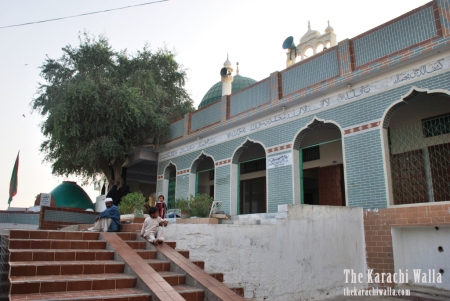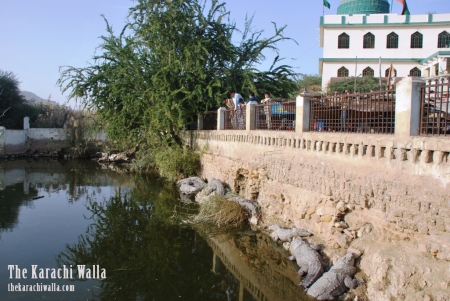

A Karachi-area shrine that boasts sulphur springs that reportedly have curative powers and a lagoon housing sacred crocodiles draws thousands of visitors daily.
The shrine memorialises Sakhi Sultan Manghopir, whose parents came to the subcontinent in the 13th century. Legend has it that Manghopir found salvation here, becoming a dervish of Sufi saint Baba Farid Ganj Shakar 600-700 years ago.
Manghopir’s shrine consists of a small room where his tomb is covered with an embroidered silk fabric. Outside, musicians sing Manghopir’s praises and the keepers of the shrine bless those who go inside.
Close to the shrine is a lagoon for crocodiles. The king crocodile is named More Sahib and presides over more than 100 other crocodiles, said animal keeper Khaleefa Sajjad Hussain.
Near the shrine staircase are some ancient Jokhio tribe graves, similar to the Chawkhandi Tombs in Karachi.
Also near the crocodile lagoon is a warm-water sulphur spring, where visitors bathe in the water, hoping to overcome skin diseases.
“This is where the impossible is possible,” one believer said.
Legend of Manghopir’s crocodiles
Several legends describe Manghopir and his crocodiles.
According to one, Baba Farid was travelling in a convoy to present-day Saudi Arabia for the Hajj when notorious bandit Mangho Wasa tried to rob the travellers. Baba Farid so charmed Mangho Wasa that the bandit converted to Islam and gave up crime. Mangho Wasa then began practicing Sufism under the guidance of Baba Farid, who later gave him the title of pir (Sufi master), making him Manghopir.
Baba Farid once conducted a chilla – a 40-day religious vigil – under a tree 2km from what was to become Manghopir’s shrine.
“Before leaving, he promised Manghopir a gift that would keep his name legendary forever,” said Chand Sabri, one of the saint’s followers. “He drew lice from his hair and told Manghopir to put them into water. Manghopir dropped the lice into the lagoon, and each louse became a crocodile – a sacred crocodile.”
Asif Chughtai, a government employee of the Religious Endowment Department, gave another version, saying Manghopir suffered from lice. When they irritated him, he stamped his feet. Two sulphur springs formed on the spot, and the lice that fell in became crocodiles.
Devotees’ attention
Ali Muhammad Shah, who looks after the shrine and has spent almost his whole life there, said visitors from Pakistan and abroad visit the shrine to pay their respects and feed the crocodiles.
“It does not matter what faith they belong to and what they follow,” Shah said. “People come to pay their respects.”
Manghopir spent his days in prayer and sought spiritual enlightenment, Shah said. His presence in the area is still a powerful draw.
“It’s a commitment we make, and then we come here to offer Fateha (a prayer from the first chapter of the Koran) and to feed the crocodiles,” said visitor Dilawar Khan of Hyderabad.
“People make a pledge at the shrine,” another shrine attendant said. “If their wish is granted, the crocodiles will accept the meat. If the mannat is rejected, the crocodiles won’t eat. If a believer’s wish is fulfilled and he fails to present sacrificial meat to the crocodiles, then the crocodiles will visit him in his dreams to remind him about the mannat.”
The crocodiles are harmless, said Hussain.
“These crocodiles make weekly treks up the marble staircase to Manghopir’s shrine,” he said. “They are his attendants.”
No comments:
Post a Comment